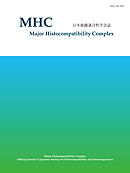
- Issue 2 Pages 101-
- Issue 1 Pages 38-
- |<
- <
- 1
- >
- >|
-
Akinori Kimura2017 Volume 24 Issue 2 Pages 101-122
Published: 2017
Released on J-STAGE: September 22, 2017
JOURNAL FREE ACCESSJapanese Society for Histocompatibility and Immunogenetics (JSHI) has a certification system for HLA technologist and Director for Histocompatibility testing, in which ability and knowledge about the histocompatibility and Immunogenetics is required. To evaluate the ability and knowledge, a paper examination is obliged. Here I will comment on several questions of which percentage of correct answer was below 40%.
View full abstractDownload PDF (964K) -
Makoto Yawata2017 Volume 24 Issue 2 Pages 123-133
Published: 2017
Released on J-STAGE: September 22, 2017
JOURNAL FREE ACCESSHuman natural killer cells (NK cells) express multiple receptors that enable these lymphocytes of innate immunity to recognize the presence of various HLA class I molecules on target cells. An important family of these receptor types is the Killer cell Immunoglobulin-like Receptors (KIRs) that encompasses vast diversity in the human populations. KIR variation results in large differences in NK cell phenotypes and function, therefore encoding personalized diversity in NK cell responses. KIR genetics have become integrated worldwide in the regimens for hematopoietic stem cell transplantation, where KIR genotypes are utilized as biomarkers to guide donor selection and transplant design. Genetic diversity of the KIR system is two-tiered: variation in gene content, and allelic polymorphisms at KIR loci. Another level of diversity in the KIR system is generated by differences in protein expression, where variegated expression of the receptors generates a wide array of NK cell subsets within the lymphocyte population of a human individual. The repertoire of NK cell subsets that differ in function is an important factor contributing to individual differences in the innate immune response, such as those against virus infection, in tumor immunosurveillance, and in hematopoietic stem cell transplantation. In this article, we will look into the mechanisms of genetic diversification in the KIR system, KIR expression and their roles in NK cell regulation, as well as the current aspects by which the KIR and HLA systems are implemented as effective biomarkers impacting clinical medicine, with a focus on hematopoietic stem cell transplantation.
View full abstractDownload PDF (1681K) -
Atsushi Yoshizawa2017 Volume 24 Issue 2 Pages 134-142
Published: 2017
Released on J-STAGE: September 22, 2017
JOURNAL FREE ACCESSThe impact of donor-specific anti-HLA antibodies (DSA) on liver allograft is still elusive. The impact of DSA may cause two types of antibody-mediated rejection (AMR); one is acute AMR (aAMR) resulting in adverse consequences during the perioperative period, and the other is chronic AMR (cAMR) causing progressive fibrosis in the late liver allograft. Liver is believed to be, to some extent, resistant to AMR. However, the evidence has accumulated that preformed DSA will cause liver graft injury. We previously experienced that the one-year survival rate of the crossmatch positive patients was 60% without taking any measures. We assured the impact of high-MFI DSA on graft survival by retrospective analysis of DSA in the sera by solid-phase detection assay by Luminex. And then, we have adopted the new strategy for DSA-positive recipients to prevent acute AMR; avoidance of the donor whose HLA were target of DSA, or desensitization by rituximab. One year survival rate has improved to be similar among DSA-positive and negative recipients. The features of chronic AMR have not been well defined. We have reported that DSA are significantly correlated with progressive centrilobular fibrosis in the late allograft liver biopsies, especially in the pediatric recipients. The similar phenomena have been observed in the adult recipients. The impact of DSA on long-term prognosis is unclear from our experience, while the graft injury have been observed in the patients with DSA. The impact of preformed DSA on the survival has been emerged, however the strategy to prevent from fatal acute AMR and close follow-up for DSA-positive patients significantly improved the survival rate. Monitoring of DSA during perioperative period is important. De novo DSA are significantly correlated with progressive fibrosis, however, the influence on the prognosis of the graft in the DSA-positive patients should be revealed through long-term observation.
View full abstractDownload PDF (1476K)
- |<
- <
- 1
- >
- >|